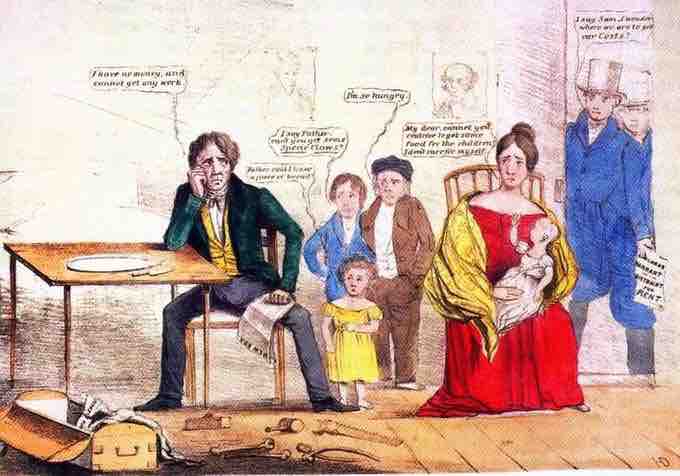The Market Revolution led to rapid expansion in manufacturing, new innovations in technology, and improvements in transportation. At the same time, the rapid expansion of the American economy made it prone to boom-and-bust cycles; it also led to dangerous working conditions and increased tensions between the North and South.
Poor Working Conditions
The Market Revolution primarily benefited wealthy planters in the South, industrialists in the North, and bankers and businessmen. Many traditionally skilled and artisanal modes of commerce were made obsolete by the improvements of the Market Revolution. Poor working conditions in factories resulted in demonstrations and organized strikes by workers, prior to the widespread prevalence of unions and organized labor. Mill strikes organized by female factory workers in Lowell, Massachusetts, in 1834 and 1836, while largely unsuccessful, involved upward of 2,000 workers and represented a major organizational effort in the early labor movement. In 1845, the trade union of the Lowell mills sent representatives to speak to the Massachusetts legislature about conditions in the factories, leading to the first governmental investigation into working conditions.
Tensions Between the North and South
The Market Revolution created new regional demarcations in respect to economic specialization. By the 1820s, plantation-style export agriculture dominated in the South, the North was the center of industry and trade, and the West was defined by the expanding frontier. Though these regions have always been interdependent, during this period, their differences became more marked, more significant, and increasingly less compatible. From 1800 to 1860 the North—without slavery—became increasingly industrialized and urbanized. The South, predominantly rural, non-industrial, and reliant on slavery, expanded into rich new lands in the Southwest, from Alabama to Texas.
This era was marked by sectionalism, or loyalty to the interests of a particular region, rather than to the country as a whole. The North and South were divided in terms of their economies, social structures, customs, and political values. Southerners argued that the North that was changing too rapidly and that the South remained true to historic republican values of the Founding Fathers, many of whom owned slaves. The issue of slavery also split the largest religious denominations (the Methodist, Baptist, and Presbyterian churches) into separate Northern and Southern denominations.
Boom and Bust Cycles
Despite the profits realized by bankers, industrialists, and planters who were beneficiaries of the Market Revolution, some individuals' fates were adversely affected by the improvements in industrialization, communication, and transportation during this period. The United States experienced the first major financial crisis of the early republic during the Panic of 1819. Earlier economic downturns had arisen from international conflicts such as the Embargo Act and the War of 1812, and these downturns had resulted in widespread domestic foreclosures, bank failures, unemployment, and slumps in agriculture and manufacturing. Prior to the Panic of 1819, American bankers, who had little experience with corporate charters, promissory notes, bills of exchange, or stocks and bonds, encouraged a land speculation boom during the first years of the Market Revolution and engaged in irresponsible lending. In the summer of 1818, the national bank managers realized the bank's massive overextension and instituted a policy of contraction and the calling in of loans. Businesses went bankrupt when they could not meet their debts, and hundreds of thousands of wage workers lost their jobs.

Whig cartoon showing the effects of unemployment
This U.S. Whig poster illustrates unemployment in 1837 through the lens of an American family, whose patriarch sits forlornly at a table while rent collectors enter the door.
Speculative fever once again crippled the U.S. economy in the Panic of 1837. Following a period of runaway inflation, on May 10, 1837, in New York City, banks began to accept payment only in specie ("hard" money of gold and silver coinage), forcing a dramatic, deflationary backlash. The Panic was followed by a five-year depression, resulting in the failure of banks and levels of unemployment which were unprecedented at that time.